Goal
I want to interpolate within groups in a dataframe. This will give me an arbitrary number of intermediate points for each group within a dataframe.
Minimal working example
I have a dataframe like:
OldDataFrame <- data.frame(ID = c(1,1,1,2,2,2),
time = c(1,2,3,1,2,3),
Var1 = c(-0.6 , 0.2, -0.8 , 1.6 , 0.3 , -0.8),
Var2 = c(0.5 , 0.7, 0.6 , -0.3 , 1.5 , 0.4) )
I want to get a function something like this:
TimeInterpolateByGroup <- function(DataFrame,
GroupingVariable,
TimeVariable,
TimeInterval){
#Something Here
}
It would be handy if I did not have to specify columns to do this on and it could operate automatically on every numeric column like numcolwise in plyr
So that I could apply it like this:
NewDataFrame = TimeInterpolateByGroup(DataFrame = OldDataFrame,
GroupingVariable = "ID",
TimeVariable = "time",
TimeInterval = 0.25)
to get the NewDataFrame as:
NewDataFrame = data.frame(ID = c( 1, 1, 1, 1, 1, 1, 1, 1, 1, 2, 2, 2, 2, 2, 2, 2, 2, 2 ),
time = c( 1, 1.25, 1.5, 1.75, 2, 2.25, 2.5, 2.75, 3, 1, 1.25, 1.5, 1.75, 2, 2.25, 2.5, 2.75, 3 ),
Var1 = c( -0.6, -0.4, -0.2, 0, 0.2, -0.05, -0.3, -0.55, -0.8, 1.6, 1.275, 0.95, 0.625, 0.3, 0.025, -0.25, -0.525, -0.8 ),
Var2 = c( 0.5, 0.55, 0.6, 0.65, 0.7, 0.675, 0.65, 0.625, 0.6, -0.3, 0.15, 0.6, 1.05, 1.5, 1.225, 0.95, 0.675, 0.4 ))
Or in picture form I want to:

Related Question that didn't quite work
Interpolate variables on subsets of dataframe
- Using a
plyrtype approach seems to be in the right direction but with a confusing example and without the ability to have an arbitrary number of intermediate interpolation points. This is important for the animation application (see below) where I am not sure how many intermediate time points I will need to get a smooth animation.
Some other answers use a time series approach but that would not allow segmenting by group.
I also considered using a longitudinal data package but that seems unnecessarily complicated for what should be a simple problem.
Desired Application
I want to have an x-y plot of Var1 and Var2 with the points being each ID point at time = 1. Then I want to use the animate package to see the points move as time increases. To do this smoothly I need all of the coordinate sets for intermediate points in time.